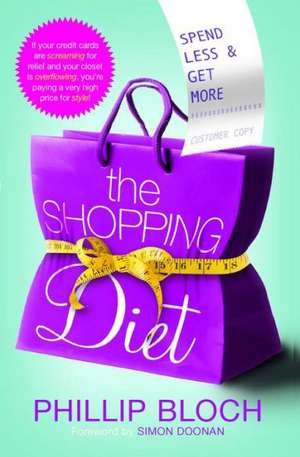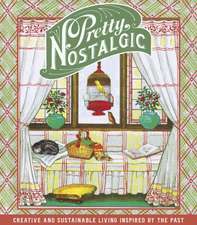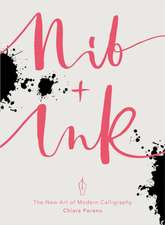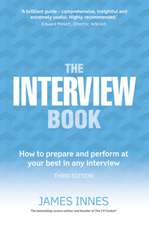The Shopping Diet: Spend Less and Get More
Autor Phillip Blochen Limba Engleză Paperback – 16 aug 2010
When the clothing budget is tight, when you have to squeeze every dollar and stretch it further, it’s time to go on The Shopping Diet. But don’t worry! This diet won’t deprive you of having a fashionable and up-to-date wardrobe—in fact, you will find exciting ways to look fantastic, make more of the clothes and accessories you already have, and come out ahead with the one thing that’s always in style: more money in your wallet!
Whether you’re an impulse shopper, whether you shop out of boredom or other emotions, or if "the tough go shopping" has always been your motto, you may feel that you simply have to shop—that there are never enough clothes, or the right clothes, to make you feel complete, confident, and in control. But in tough economic times, there is a better way—a whole new lifestyle of evaluating your true wardrobe needs, making smart choices, and changing your spending habits from the inside out. The results? More time (no more Saturdays spent wandering the mall aimlessly), more space (your closet makeover will turn that priceless piece of real estate into your favorite go-to boutique!), and more cash (or, if you prefer, less credit card debt). Now that’s being in control!
Premiere celebrity stylist Phillip Bloch’s unique and thought-provoking approach to looking great for less gives you fascinating insights and practical solutions to the very real problem of overspending that affects millions of people.
Preț: 107.00 lei
Nou
Puncte Express: 161
Preț estimativ în valută:
20.47€ • 21.34$ • 16.95£
20.47€ • 21.34$ • 16.95£
Carte disponibilă
Livrare economică 13-27 martie
Preluare comenzi: 021 569.72.76
Specificații
ISBN-13: 9781439110263
ISBN-10: 1439110263
Pagini: 288
Dimensiuni: 135 x 210 x 23 mm
Greutate: 0.24 kg
Editura: SIMON SPOTLIGHT ENTERTAIN
Colecția Gallery Books
ISBN-10: 1439110263
Pagini: 288
Dimensiuni: 135 x 210 x 23 mm
Greutate: 0.24 kg
Editura: SIMON SPOTLIGHT ENTERTAIN
Colecția Gallery Books
Notă biografică
The premier fashion stylist to the stars, Phillip Bloch works with Hollywood’s A-list, including such celebrity clients as John Travolta, Sandra Bullock, Faye Dunaway, Selma Hayek, and Jada Pinkett Smith. A regular commentator on television and a contributor to Vanity Fair, Vogue, InStyle, Premiere, Entertainment Weekly, Elle, Detour, and ABC.com (as a pop culture guru), Phillip’s unique combination of expertise and humor has made him one of the most sought-after and outspoken stylists in Hollywood. The clothing consumer’s much needed answer to It’s All Too Much, The Shopping Diet shows how a clutter-free closet can help readers reclaim their lives by changing their spending habits. The Shopping Diet Spending Less and Getting More Phillip Bloch 18
Extras
Admit You’re an Overshopper
It’s hard to resist buying compulsively when the world is one big Willy Wonka Chocolate Factory of clothes, shoes, and sparkling accessories. Now more than ever, it’s not okay to carelessly throw a random pair of sunglasses or another bottle of perfume into your cart just because they’re there and they sparkle and you love them . . . or you at least love the packaging.
We all have access to shopping twenty-four hours a day, seven days a week. For anyone with a penchant for overshopping, temptation is constantly calling in the form of shiny window displays, the barrage of store catalogs in your mailbox, and online offers clogging your email inbox. Credit cards are the fuel for this raging fire. It has become abundantly clear in the last few years that credit card companies want nothing more than to give us a gazillion dollars in credit, wait until we miss a minimum payment or don’t read the fine print in the contracts, and then let interest rates soar. Living on credit can be an oh-too-alluring trap, especially with the credit card companies’ appealing incentives of travel miles and luxurious rewards. Time and time again, you have heard that all that glitters is not gold (or even platinum, despite what your credit card would infer). But if you keep overcharging on your AmEx, you might end up buried in the red. The result: If you don’t pay off your bill for that $10 tank top when the first invoice arrives, it can end up costing you $100 within the year, thanks to fluctuating and unpredictable interest rates.
Even worse than paying ten times more than what you thought you spent on a flimsy top, unfettered credit can lead to no credit at all. If you can’t keep up with your spending, your assets could quickly become your liabilities. Your credit card could be canceled, plummeting your fragile credit score. Down the road, when you really need a line of credit to purchase something imperative (a new apartment, a new car, etc.), you’ll find yourself in a real jam. Do you realize that some companies even look at your credit score when you apply for a job?
If you face credit problems, you are not alone. The average person’s debt in the United States has risen to a staggering number. Recently, banks have been starting to dig even deeper than your credit score in order to determine eligibility for loans or more credit. In fact, overall accumulated debt is starting to be assessed and considered an equally important deciding factor. But you can beat the statistics by facing your shopping problem. If you are feeling powerless over your shopping habits and overspending, trust me, you can move beyond it. I’m here to see to it that you don’t waste another dollar on things you don’t need. Once you realize that your goal in life is not to buy the most things but to buy the best, the rest will become easier.
The first step in conquering any problem is to admit that you have one. However positive or negative the current economy may be, it is crucial to learn from the way you use, and possibly abuse, your finances when it comes to shopping. Do you have a problem? And if so, how bad is it? Treat your experiences of past irresponsible shopping as you would a new pair of shoes—you already paid for them mentally and financially, so you might as well put them to use.
Food for Thought
The Shopping Diet will only work for you if you make it work. So throughout the book, I will ask you to reflect honestly on your own habits. This will lead to a self-awareness where you will then be able to use the solutions provided in each step. Here are a few questions about how you shop:
Do you shop with a list or do you buy on the fly?
When purchasing an item, do you bother to take into account whether you already own something similar?
When budgeting for shopping, are you relying on the Psychic Network or tapping into your own ESP (Extra Spending Powers) to predict how to spend future income that may never even materialize?
Shopping Reality Check
Whether your buying sprees would make a celebutante heiress blush or you feel you simply shop unwisely, there’s a lot to be learned by analyzing your spending patterns. This will take a little detective work. First, collect your bank statements, credit card bills, and receipts from the past six months. If you don’t keep those types of documents, you should! Start collecting them immediately and do the following exercise after one month (then repeat after three months).
I want you to answer these questions about your spending habits as honestly as you can. They are here to help you understand where and when you shop till you drop. No one else has to see them. Habits become clearer once you really look at the cold hard facts.
Find and write down your three most budget-busting shopping sprees. Whether it was only an hour or a two-day frenzy, record the date, how long the spree lasted, and the total amount that you spent.
1._______________________________________________________
2._______________________________________________________
3._______________________________________________________
Reflect on each one of these sprees by identifying the items that you bought. Were these items planned or unplanned purchases? And were they necessary or unnecessary?
1._______________________________________________________
2._______________________________________________________
3._______________________________________________________
Now that you’ve listed the items you purchased and addressed whether they were needed, continue on your reality check and see if these items were appropriate purchases or excessive. For example, you may have needed new water glasses, but did you really have to buy a service of twenty? Or did they really need to have the same designer label as your shirt? Did you end up loving your purchases as much as you thought you would in the store (the answer might be yes, and that’s okay)? We’re working on perspective, so we need to dig even deeper than your receipt pile.
What’s Eating You?
Like an overeater who uses food as an emotional outlet, you need to figure out what compels you to whip out that credit card. You need to understand the way you shop. You need to know why you buy, buy, and buy again so that the next time you actually have the power and knowledge to resist. Those shoes look sexy when they’re on the shelf and on sale. You think you can afford them, so you quickly buy them. But the euphoric endorphin rush passes when you put them in your closet and realize once again that you have way too many shoes in the first place. And though they may have been on sale, were they really a bargain? That question will quickly be answered with the arrival of the credit card bill . . . and subsequently, any remaining good feelings will come to a screeching halt. You don’t want to be a part of that merry-go-round anymore, so let’s get off that ride by figuring out your triggers.
Many people suffer from low self-esteem issues and don’t believe that they deserve to have happiness in their lives. But far too many people in this celebrity-inspired, egocentric, and attention-grabbing culture also suffer unconsciously from habits of overindulgence and gluttony. While these two traits may seem in opposition to each other, both are often a manifestation of the same syndrome of overcompensation. Both come from an unhealthy place of unnecessarily wanting to prove and validate oneself to others.
As the Dr. Phil of Fashion, I don’t have to pick your brain to find out the true psychological issues of why you shop and spend too much. And I’m sure you don’t want to deal with a label, either (unless it’s a designer one on a piece of clothing). You are willing to go on The Shopping Diet, which is good enough for me. However, in my business, I hear men and women talk about everything under the sun, especially shopping. And after years of listening to clients who range from PTA moms to celebrity icons, I have boiled down the causes for overshopping to four basic motivations: childhood habits, the opposite sex, low self-esteem, and competition. Let’s analyze.
CHILDHOOD HABITS
If you think about it long enough, you can usually trace the roots of your feelings about shopping back to your parents. There are far too many adults who were dragged to malls and department stores when they were children. There was no babysitter, so Macy’s became their playground. I have a friend whose mother was the belle of the ball on the cocktail party circuit in her little hometown. The mister of the house was a prominent physician. Saturdays for this little girl were not spent as quality time with her parents, baking cookies with mom or four-wheeling with dad. Love and attention came in the form of mom’s shopping trips for the dress with tulle that would have made Bjork’s Oscar swan gown look like an understated shift, followed by hours of trying on patent leather Mary Janes in various department stores.
Some adults got the stamp of approval to “shop till you drop” from watching their parents do the same thing. Family outings were composed of carrying heavy shopping bags until the handles became engraved into their palms. These people remember their parents buying lavish items week after week and therefore associate possessions with happiness. Conversely, there is another type of child whose family could perhaps not afford the finer things in life and struggled to make ends meet. This child felt deprived of what everyone else seemed to possess, which becomes the driving force in adulthood. These people buy to prove to themselves and to others that they are valid and valuable. Both of these types of children grew up into adults who feel like shopping is their God-granted mission in life. They may pay minimums on their high-balance credit cards, yet there’s no stopping them from cruising the mall for the latest goods each weekend and overcompensating by overbuying. The connection to their parents is intrinsically linked to the excitement of purchasing. As adults, they will never stop spending in their futile efforts to try to re-create or validate the past.
Do you want to return to simpler childhood times by heading into a store? The only problem is now daddy no longer foots the bill—you do. It is time to do a life update because you cannot afford to continue down memory lane.
THE OPPOSITE SEX
You only get one chance to make a first impression. The truth is that the first moment of connection with a potential significant other is purely based on image projection—as are most initial meetings. The visual attraction will hopefully stimulate a physical attraction, which will perhaps in turn transform into an emotional one. So it makes sense that most of us are obsessed with what we wear and how we present ourselves, even if perhaps some of us act like we’re not (that, too, is just an act).
When getting ready for that first date, you inevitably want to display your feminine wiles, yet you don’t want to look like you’re getting ready for a photo shoot with Playboy. Yes, you want people to love you. But do you ever let the real you show up? Or do you just keep sending a false representative out of your closet to do your PR? You might be having dinner with the person of your dreams in an outfit emulating the latest fashion magazine cover or your favorite film or pop star. But we know that entire look came with a huge price.
Women love a man who dresses up for a date, but guys don’t see things in quite the same way. Most men, in fact, are not requesting anyone perfect. They’re just looking for a woman who they can work with and is worth it. The truth of the matter is that the guy eating that burger across the table from you is looking hard at that designer bag of yours thinking, I know that I can afford the meal, but can I afford her? High maintenance comes with a high price. You might end up pushing him away when he’s actually a man you want to pull in closer.
So, girls, before you go gallivanting off to make your next Galliano purchase, here is a little something to consider: A man really just cares about what you look like in clothes (and even more about how you look out of them). It doesn’t matter to him if those clothes are designer or discount. As long as they fit you and you’re looking smoking hot, you will be fitting for him. If he asks you to dress to impress, it’s rarely for himself. It’s for when you meet his family, his friends, or his boss. Believe me, if the man had his way and had you all to himself, you probably wouldn’t be wearing many clothes at all! It’s time to realize he’s not reading your designer labels. A real man worth his weight in gold isn’t interested in who you’re wearing but how you’re wearing it.
LOW SELF-ESTEEM
The regular girl (size 12–14, because that is the American average) probably dreads shopping because she doesn’t look like anyone she sees on TV, on film, or in magazines. It becomes an excuse to let herself go. Girls who are full figured can turn themselves into self-saboteurs. The shopping and eating become a never-ending cycle of guilt. These shoppers shop because they’re unhappy about themselves. Then they eat because they’re unhappy that they shopped so much. This unhappiness is only exacerbated when they can’t fit into the items they bought due to their overeating. “I eat because I’m unhappy and I’m unhappy because I eat” is a vicious cycle.
Do you tell yourself that Ben, Jerry, the Keebler Elves, and Aunt Jemima aren’t judging? Do you tell yourself that the designers are the ones to blame because they don’t make clothes for your body type and shape? Or that the stores are at fault because they are not selling clothes for the “real” woman? The reality is that much of this attitude stems from self-loathing. These girls find temporary happiness in the things that don’t have a clothing size—the expensive skin creams, the dazzling earrings, the designer pumps, the endless pairs of stockings, tummy tuckers, and booty lifters. But all the shape shifters in the world aren’t going to put you in a permanently perfect mental shape. First and foremost, you need to believe in yourself—whether this renewed sense of self-esteem comes from a concerted effort to lose the economic, emotional, and physical weight or from simply becoming content with who you are. At least come to terms and be honest with your feelings. Suddenly, it won’t be about what you have or don’t have, but about the limitless possibilities you have opened yourself up to.
COMPETITION
I’ve heard women talk about shopping like it is a competitive sport. They’re out with their girlfriends and one finds a great silk shirt on sale, so naturally another has to buy something even more fabulous that either costs a lot more or was an even bigger bargain. Now the race is on to find anything of value before you leave, including those olive green D’Orsay pumps that you’ll never wear because you have no idea what to pair them with in your wardrobe. How would life be fair if your girlfriend got the great sale item and you walked out of the store after hours of dedicated digging with nothing more than sore feet? Oh, the pain of those unproductive shopping hours!
BLOCHBUSTER TIP
Before buying any last-minute item, ask yourself, “Do I really need this? What is its perceived value compared to what it’s really worth? In what way will this item add value to my look . . . or my life?” Nine times out of ten, your answers to these three questions will make you put that little item back.
The whole idea of competition is semi-self-defeating. If you keep looking back to see if someone is catching up, you’ll miss where you’re going. If a girlfriend finds something beautiful, be happy for her treasure. Maybe you’ll be the one next time who hits the big prize. The bottom line is that shopping is never a competition and you can quickly waste a lot of hard-earned money trying to match your friends, purchase for purchase. And if you and your girlfriend are really good friends, I’m sure she’ll let you borrow that steal of a shirt, anyway!
You have come to see that your spending actually has patterns. And I’m not talking about bold floral ones. It’s time to raise your consciousness like André Courrèges raised hemlines with the miniskirt and start making informed purchases. Courrèges showed a lot more leg . . . you need to show a lot more sense! When watching your weight, you always consider the caloric intake of the things you eat and imagine how it will affect your body weight. Similarly in shopping, it’s the economical and emotional weight of your purchase that you must consider so that you don’t get caught in the same shopping traps again and again. I promise that when you sort through the free-for-all in your closet and change your thought process, your buying and shopping habits will change, your budget will be greener, and your stress levels will be leaner. You have taken that first step by admitting to an overabundance of clothing and stuff that is just waiting to be reassessed and reworked . . . or removed.
Look in the mirror and say the following words out loud: My goal is to have the knowledge to shop safely and responsibly, and the ability to remain true to my budget through working the steps ofThe Shopping Diet.
Okay, now let’s turn that motivation into real commitment with the next big step.
© 2010 Phillip Bloch
| Note |
|---|








